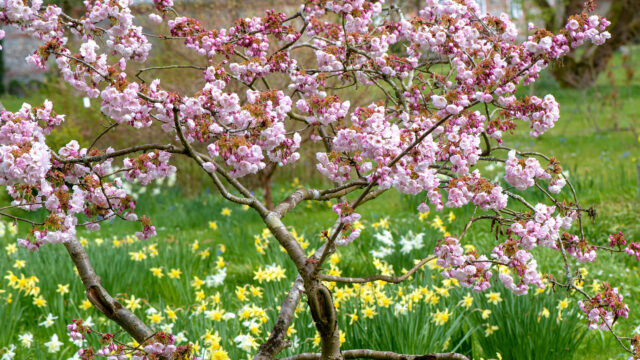When it comes to growing cherry trees, timing is everything. Knowing when to prune your cherry trees can have a profound effect on the amount of fruit they produce. Pruning at the right time can help maximize production and ensure you enjoy a plentiful harvest of juicy cherries.
But what is the best time to prune your cherry tree? That’s precisely what will explore in this article – Timing is Everything: When to Prune Your Cherry Trees for Maximum Fruit Production. We will look at how different times of year impact growth patterns, understand seasonal cycles that influence fruit production, and ultimately provide guidance on when you should prune your cherry trees for maximum results.
So join us as we uncover everything you need to know about when it’s best to trim your treasured cherry tree!
Understanding Cherry Tree Pruning Timing
Understanding when to prune cherry trees is essential for maximizing fruit production. Pruning should be done during the dormant period, which typically occurs in late winter or early spring.
This helps minimize damage to flowers and buds that will later become fruit. Regular maintenance may also be needed during the growing season to shape the tree and remove any diseased branches. Before beginning any pruning work, it’s important to understand the growth cycle of a cherry tree, as improper trimming can reduce yield or even kill a mature tree if not handled correctly.
Depending on the age and health of your trees, you can determine what type of pruning is necessary, whether it’s light shaping or more extensive renewal, and estimate how much time each particular job might take. Knowing when and how to properly prune your cherry trees will ensure healthy growth for years to come and bountiful harvests in the autumn!
Choosing the Best Time to Prune Your Cherry Trees

When it comes to pruning cherry trees, timing is essential. Pruning too early or late in the season can reduce fruit production and even stunt tree growth. To ensure maximum fruit production and a healthy tree, you need to know when best to begin pruning your cherry trees. The optimal time for pruning depends on the type of cherry tree, as well as its location.
In general, most species should be pruned during winter dormancy—typically between mid-November and mid-March in mild climates. This will allow your trees enough time before bloom to recover from any shock caused by trimming away branches. If you live in a colder climate, wait until after all danger of frost has passed (usually around late April) before starting the process of pruning your cherry trees.
It’s also important that you avoid “topping” your cherries – where cut off large sections at once – as this can cause severe damage that can take years for a tree to recover from fully if ever at all! Instead, focus on thinning out dead wood and removing diseased branches first; then move on to making judicious cuts here and there to maintain an open center structure allowing more light into the canopy so that fruits form evenly across each branch.
Finally, don’t forget about basic maintenance such as removing suckers sprouting from below ground level which could rob energy from fruiting branches higher up if left unchecked! By following these steps carefully with consideration for different climates and types of cherries, you’ll be able to enjoy maximum yields come harvest season!
Maximizing Fruit Production Through Pruning
When it comes to pruning cherry trees, timing is everything. Knowing when and how to appropriately prune a tree can make all the difference in fruit production. Properly timed pruning encourages new growth that leads to more vibrant fruit production.
Though there are many different types of cherry trees, understanding the basics of each variety can help maximize their potential for producing an abundance of delicious cherries. For example, sweet cherry varieties such as Bing and Lamberts require regular annual pruning after they have reached maturity or else they will produce fewer fruits over time due to overcrowding from older branches and leaves blocking sunlight from reaching the younger shoots.
Tart cherries like Montmorency respond well to hard pruning every two years or so; this helps keep them at the optimal size for maximum yield without sacrificing quality or flavor. No matter what type of cherry tree you have in your yard, proper timing is essential for successful fruit production through pruning techniques such as thinning out old woody branches, removing deadwood, reducing overcrowding, and shaping the overall canopy structure by cutting back lateral shoots while preserving central leaders and scaffold branching systems where applicable.
Taking into consideration these steps along with seasonal weather conditions can create a balanced approach towards achieving consistent yields year after year while also maintaining healthy vigor during peak fruiting seasons each spring!
Preparing for Pruning: Establishing a Routine Maintenance Schedule

Creating and maintaining a regular pruning schedule is essential for achieving maximum fruit production from your cherry trees. Timing is critical when it comes to determining the right moment to start pruning and continuing with routine maintenance. Depending on the species, you should begin pruning in either late winter or early spring.
When new growth appears, look closely at each tree’s canopy structure and branches so you can identify any dead or diseased limbs that need to be removed. Be sure that your cuts are made cleanly and precisely – even small jagged edges can contribute to disease spread if not properly addressed. When considering which branches should stay and which ones should go, consider what will promote air circulation within the tree as well as light penetration for the photosynthesis of fruits underneath the foliage line.
The goal is to maintain an open center structure by removing crossing limbs, too-closely spaced shoots, suckers growing from roots near the base of trunks, and crowded inner leaf growths along main branches – all without sacrificing their natural shape or beauty!
Additionally, make sure that you avoid cutting back more than 25% of a single branch’s length during any one season; this may cause undue stress on the tree’s root system resulting in reduced fruiting capabilities down the road. By following these steps while creating a routine maintenance schedule tailored specifically for your cherry tree’s needs, you will be able to maximize their ability to produce sweet delicious fruit year after year!
Avoiding Mistakes in Cherry Tree Pruning
Pruning your cherry trees is a delicate process—one wrong move and you could end up with fewer fruits than expected. Here are some tips for avoiding mistakes in cherry tree pruning:
- Know the right time to prune – Pruning at the right time of year will ensure maximum fruit production, so figure out what kind of climate you live in and determine when its best to start trimming away.
- Understand the purpose of pruning – Picking out branches isn’t just about making a tree look neat; each cut should serve a purpose such as promoting air circulation or preventing disease outbreaks by removing deadwood.
- Use caution with tools – Dull blades can cause more harm than good, potentially ripping through tissue instead of cleanly cutting it off, so be sure to sharpen your tools before beginning any project involving them.
- Don’t overdo it – It may be tempting to take off excess branches but resist that urge if possible; too much aggressive pruning can weaken a tree’s structure and make it vulnerable to damage from strong winds or heavy snowfall during wintertime months.








